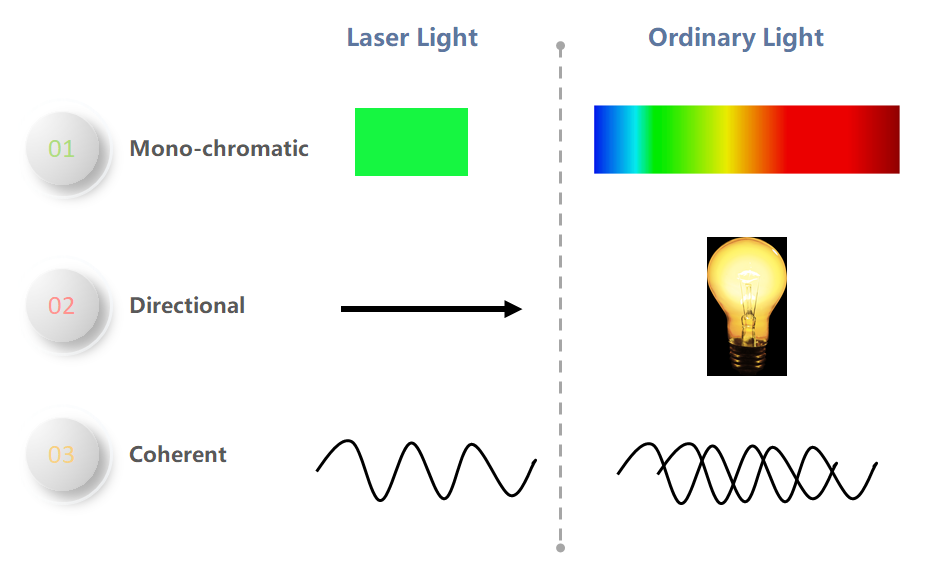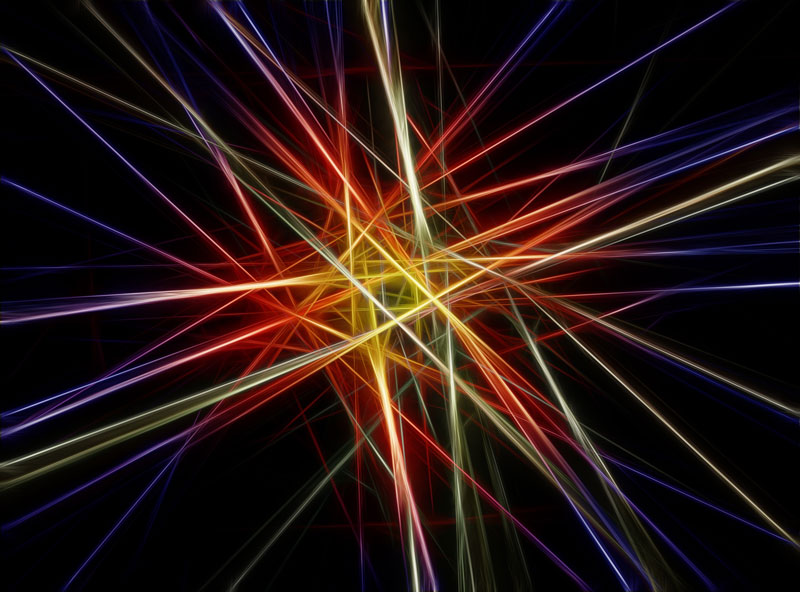Shopping Guide @ CoolLaserPointers.com

Laser Light Differs From Ordinary Light
“Laser” is an acronym for light amplification by stimulated emission of radiation. A laser is created when the electrons in atoms in special glasses, crystals, or gases absorb energy from an electrical current or another laser and become “excited.” The excited electrons move from a lower-energy orbit to a higher-energy orbit around the atom’s nucleus. When they return to their normal or “ground” state, the electrons emit photons (particles of light).
These photons are all at the same wavelength and are “coherent,” meaning the crests and troughs of the light waves are all in lockstep. In contrast, ordinary visible light comprises multiple wavelengths and is not coherent.
Laser light is different from normal light in other ways as well. First, its light contains only one wavelength (one specific color). The particular wavelength of light is determined by the amount of energy released when the excited electron drops to a lower orbit. Second, laser light is directional. Whereas a laser generates a very tight beam, a flashlight produces light that is diffuse. Because laser light is coherent, it stays focused for vast distances, even to the moon and back.
Laser Classification
At the moment, there are two popular classification systems, the old version used before 2002, and a “new version” that is part of the revised IEC 60825 standard and ANSI Z136.1 standard. Since 2007, the new version has been accepted by the FDA for importing lasers into the United States.
| FDA Class | IEC Class | Laser Product Hazard | Product Examples |
|---|---|---|---|
| I | 1, 1M | Considered non-hazardous. Hazard increases if viewed with optical aids, including magnifiers, binoculars, or telescopes. | Laser pointers, CD/DVD players |
| II, IIa | 2, 2M | Hazard increases when viewed directly for long periods of time. Hazard increases if viewed with optical aids. | Bar code scanners |
| IIIa | 3R | Visible continuous lasers in Class 3R are limited to 5 mW. Depending on power and beam area, can be momentarily hazardous when directly viewed or when staring directly at the beam with an unaided eye. Risk of injury increases when viewed with optical aids. | Laser pointers |
| IIIb | 3B | The accessible emission is limited to below 500mW. Immediate skin hazard from direct beam and immediate eye hazard when viewed directly. | Laser light show projectors, industrial lasers, research lasers |
| V | 4 | Class 4 is the highest and most dangerous class of laser, including all lasers that exceed the Class 3B. Immediate skin hazard and eye hazard from exposure to either the direct or reflected beam; may also present a fire hazard. | Handheld Laser, Laser light show projectors, industrial lasers, research lasers, lasers used to perform LASIK eye surgery |

Key Factors To Laser Visibility
- Output Power
- The higher the power output, the brighter and more capable of burning
- Visual sensitivity of the eye to laser
- Green > Blue > Red > Violet
- Under the same power conditions, the green laser will be much brighter due to our eye
- Beam Diameter
- The beam diameter plays an important role in brightness and capability
- The smaller you are able to focus the end spot, the more powerful or capable it is of burning
- Environments
- The laser spot, or the end dot is visible under direct sunlight, but never the laser beam
Laser Pointer Applications
Our lasers are bright and sometimes too bright for pointing purposes. If pointing is your major application, stick to the laser pointers in the lower power output range. Our handheld and portable lasers are not laser pointers and are not suitable for pointing, especially indoors. Below table list suggestions for power outputs for pointing for each color of lasers we offer in the laser pointers.
*If a visible laser beam in darkness is required for your application, we suggest purchasing green or blue laser in a respectable power range. Please note that the beam of a 5mW violet or red laser is not visible in darkness.
| Laser Color | Small Medium Classroom Teasing Cats and Dogs |
Auditorium | Outdoors(Daytime) Astronomy(Night) |
Burning |
|---|---|---|---|---|
| Violet | 5mW – 50mW | 80mW – 200mW | Choose Blue/Green | Choose Blue/Green |
| Red | 5mW – 50mW | 80mW – 200mW | Choose Blue/Green | Choose Blue/Green |
| Green | 5mW – 15mW | 20mW – 50mW | ≥ 50mW | ≥ 200mW |
| Blue | 5mW | 50mW – 200mW | ≥ 80mW | ≥ 200mW |
Burning Laser Pointer
- If burning is an attribute you’re looking for in a laser, we recommend the powerful burning laser pointer( >500mW). We’re not going to cover what items a powerful laser pointer can burn and t you explore the possibilities. Popular items to burn with a powerful laser pointer seem to be balloons, electrical tape, matches, paper, and wood, however, we assure you that lasers can do quite a bit more.
- If we can reduce the area of a laser’s end spot, ideally into a pin-point, we can increase intensity making a laser more capable. Our focus-adjustable lens does exactly this by generating a focal point outside the laser. This feature in addition to the already incredibly high power outputs make these lasers extremely capable, a device that can be potentially dangerous if handled incorrectly. This is more reason to always wear laser safety goggles while handling our powerful laser pointers.
- *As a laser is just a beam of light, the item that a laser can burn must be black or dark in color. This is because darker colored objects absorb light whereas lighter colored objects reflect it.
